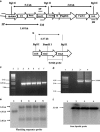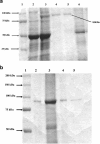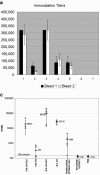Plant-based vaccine: mice immunized with chloroplast-derived anthrax protective antigen survive anthrax lethal toxin challenge
- PMID: 16299323
- PMCID: PMC1307059
- DOI: 10.1128/IAI.73.12.8266-8274.2005
Plant-based vaccine: mice immunized with chloroplast-derived anthrax protective antigen survive anthrax lethal toxin challenge
Abstract
The currently available human vaccine for anthrax, derived from the culture supernatant of Bacillus anthracis, contains the protective antigen (PA) and traces of the lethal and edema factors, which may contribute to adverse side effects associated with this vaccine. Therefore, an effective expression system that can provide a clean, safe, and efficacious vaccine is required. In an effort to produce anthrax vaccine in large quantities and free of extraneous bacterial contaminants, PA was expressed in transgenic tobacco chloroplasts by inserting the pagA gene into the chloroplast genome. Chloroplast integration of the pagA gene was confirmed by PCR and Southern analysis. Mature leaves grown under continuous illumination contained PA as up to 14.2% of the total soluble protein. Cytotoxicity measurements in macrophage lysis assays showed that chloroplast-derived PA was equal in potency to PA produced in B. anthracis. Subcutaneous immunization of mice with partially purified chloroplast-derived or B. anthracis-derived PA with adjuvant yielded immunoglobulin G titers up to 1:320,000, and both groups of mice survived (100%) challenge with lethal doses of toxin. An average yield of about 150 mg of PA per plant should produce 360 million doses of a purified vaccine free of bacterial toxins edema factor and lethal factor from 1 acre of land. Such high expression levels without using fermenters and the immunoprotection offered by the chloroplast-derived PA should facilitate development of a cleaner and safer anthrax vaccine at a lower production cost. These results demonstrate the immunogenic and immunoprotective properties of plant-derived anthrax vaccine antigen.
Figures







Similar articles
-
A plant based protective antigen [PA(dIV)] vaccine expressed in chloroplasts demonstrates protective immunity in mice against anthrax.Vaccine. 2011 Jun 15;29(27):4521-33. doi: 10.1016/j.vaccine.2011.03.082. Epub 2011 Apr 17. Vaccine. 2011. PMID: 21504775
-
Generation of protective immune response against anthrax by oral immunization with protective antigen plant-based vaccine.J Biotechnol. 2014 Apr 20;176:1-10. doi: 10.1016/j.jbiotec.2014.01.033. Epub 2014 Feb 15. J Biotechnol. 2014. PMID: 24548460
-
Expression of Bacillus anthracis protective antigen in transgenic chloroplasts of tobacco, a non-food/feed crop.Vaccine. 2004 Oct 22;22(31-32):4374-84. doi: 10.1016/j.vaccine.2004.01.069. Vaccine. 2004. PMID: 15474731 Free PMC article.
-
Chloroplast-derived anthrax and other vaccine antigens: their immunogenic and immunoprotective properties.Expert Rev Vaccines. 2006 Dec;5(6):839-49. doi: 10.1586/14760584.5.6.839. Expert Rev Vaccines. 2006. PMID: 17184221 Review.
-
Molecular basis for improved anthrax vaccines.Adv Drug Deliv Rev. 2005 Jun 17;57(9):1266-92. doi: 10.1016/j.addr.2005.01.028. Epub 2005 Apr 21. Adv Drug Deliv Rev. 2005. PMID: 15935874 Review.
Cited by
-
A multi-epitope plant-made chimeric protein (LTBentero) targeting common enteric pathogens is immunogenic in mice.Plant Mol Biol. 2020 Jan;102(1-2):159-169. doi: 10.1007/s11103-019-00938-3. Epub 2019 Dec 10. Plant Mol Biol. 2020. PMID: 31820286 Free PMC article.
-
Complete plastid genome sequence of Daucus carota: implications for biotechnology and phylogeny of angiosperms.BMC Genomics. 2006 Aug 31;7:222. doi: 10.1186/1471-2164-7-222. BMC Genomics. 2006. PMID: 16945140 Free PMC article.
-
The role of heterologous chloroplast sequence elements in transgene integration and expression.Plant Physiol. 2010 Apr;152(4):2088-104. doi: 10.1104/pp.109.152017. Epub 2010 Feb 3. Plant Physiol. 2010. PMID: 20130101 Free PMC article.
-
Plant plastid engineering.Curr Genomics. 2010 Nov;11(7):500-12. doi: 10.2174/138920210793175912. Curr Genomics. 2010. PMID: 21532834 Free PMC article.
-
Plastids: The Green Frontiers for Vaccine Production.Front Plant Sci. 2015 Nov 17;6:1005. doi: 10.3389/fpls.2015.01005. eCollection 2015. Front Plant Sci. 2015. PMID: 26635832 Free PMC article. Review.
References
-
- Ascenzi, P., P. Visca, G. Ippolito, A. Spallarossa, M. Bolognesi, and C. Montecucco. 2002. Anthrax toxin: a tripartite lethal combination. FEBS Lett. 531:384-388. - PubMed
-
- Audibert, F. 2003. Adjuvants for vaccines, a quest. Int. Immunopharmacol. 3:1187-1193. - PubMed
-
- Aziz, M. A., S. Singh, P. Anand Kumar, and R. Bhatnagar. 2002. Expression of protective antigen in transgenic plants: a step towards edible vaccine against anthrax. Biochem. Biophys. Res. Commun. 299:345-351. - PubMed
-
- Cohen, S., I. Mendelson, Z. Altboum, D. Kobiler, E. Elhanany, T. Bino, M. Leitner, I. Inbar, H. Rosenberg, Y. Gozes, R. Barak, M. Fisher, C. Kronman, B. Velan, and A. Shafferman. 2000. Attenuated nontoxinogenic and nonencapsulated recombinant Bacillus anthracis spore vaccines protect against anthrax. Infect. Immun. 68:4549-4558. - PMC - PubMed
-
- Collier, R. J., and J. A. Young. 2003. Anthrax toxin. Annu. Rev. Cell Dev. Biol. 19:45-70. - PubMed
Publication types
MeSH terms
Substances
Grants and funding
LinkOut - more resources
Full Text Sources
Other Literature Sources
Medical
Miscellaneous

